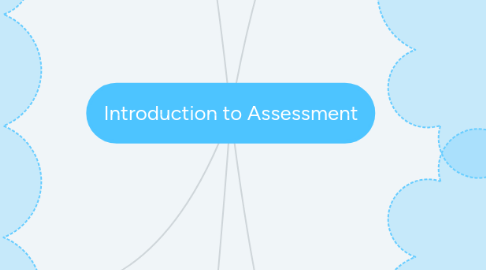
1. Chapter 3:Instructional Goals and Objectives: Foundation for Assessment
1.1. Taxonomy of Educational Objectives
1.1.1. 1. Cognitive Domain
1.1.1.1. Knowledge outcomes and intellectual abilities and skills
1.1.2. 2. Affective Domain
1.1.2.1. Attitudes, interest, application and modes of adjustment
1.1.3. 3. Psychomotor Domain
1.1.3.1. Perceptual and motor skills
1.2. Other Sources for Lists of Objectives
1.2.1. 1. Professional Association Standards
1.2.2. 2. State Content Standards
1.2.3. 3. Methods Books
1.2.4. 4. Yearbooks and subject matter standards publications of educational organizations
1.2.5. 5. Encyclopedia of educational research
1.2.6. 6. Curriculum frameworks and guides
1.2.7. 7. Test manuals
1.2.8. 8. Banks of objectives
1.3. Criteria for Selecting Appropriate Objectives
1.3.1. 1. Do objectives include all important outcomes of the course?
1.3.2. 2. Are objectives in harmony with the content standards of state or district and with general goals of school?
1.3.3. 3. Are objectives in harmony with sound principles of learning?
1.3.4. 4. Are objectives realistic in terms of abilities of the students and the time and facilities available?
1.4. List of Relevant Learning Outcomes
1.4.1. 1. Completeness
1.4.2. 2. Appropriateness
1.4.3. 3. Soundness
1.4.4. 4. Feasibility
2. Chapter 4: Validity
2.1. Validity
2.1.1. evaluation of adequacy and appropriateness of the interpretations and uses of assessment results
2.2. Concepts of Validity
2.2.1. 1. Appropriateness
2.2.2. 2. Matter of degree
2.2.3. 3. Specific to some particular use or interpretation
2.2.4. 4. Unitary concept
2.2.5. 5. Overall evaluative judgement
2.3. 5 Sources of Evidence in Validity
2.3.1. a) Test content
2.3.2. b) Response processes
2.3.3. c) Internal structure
2.3.4. d) relations to other variables
2.3.5. e) consequences of testing
2.4. Assessment Validation
2.4.1. Content
2.4.2. Construct
2.4.3. Assessment criterion relationship consequences
2.5. Methods Used in Construct Validation
2.5.1. 1. Defining domain or tasks to be measures
2.5.2. 2. Analyzing the response process required by assessment tasks
2.5.3. 3. Comparing the scores of known groups
2.5.4. 4. Comparing scores before and after a particular learning experience or experimental treatment
2.5.5. 5. Correlating scores with other measures
3. Chapter 5: Reliability
3.1. Reliability
3.1.1. consistency of measurement
3.1.2. refers to results obtained with an assessment instrument and not the instrument itself
3.1.3. particular type of consistency
3.1.4. necessary but not sufficient for validity
3.1.5. assessed primarily with statistical indices
3.2. Correlation Coefficient
3.3. Validity Coefficient
3.4. Reliability Coefficient
3.5. Factors Influencing Reliability Measures
3.5.1. Numbers of assessment tasks
3.5.2. Spread of scores
3.5.3. Objectivity
3.6. Methods of Estimating Reliability
3.6.1. 1. Test-Retest Method
3.6.2. 2. Equivalent-Forms Method (without time interval)
3.6.3. 3. Equivalent- Forms Method (with time interval)
3.6.4. 4. Split half method
3.6.5. 5. Kuder-Richardson Method
3.6.6. 6. Interrater Method
4. Chapter 1: Educational Testing and Assessment: Context, Issues and Trends
4.1. Factors that Make Tests and Assessments
4.1.1. 1. Tests and Assessments are relatively inexpensive compared to changes that involve increases in instructional time
4.1.2. 2. Testing and Assessments can be externally mandated
4.1.3. 3. Testing and Assessment changes can be rapidly implemented
4.1.4. 4. Results are visible and routinely reported by press
4.2. 5 Decades of Test-Based Educational Reform
4.2.1. Title I
4.2.2. Minimum Competency Testing
4.2.3. Nation at Risk
4.2.4. Standards Based Reform
4.2.5. No Child Left Behind
4.3. 6th Decade of Reform/Technological Advances
4.3.1. 1. Partnership for Assessment of Readiness for College and Careers (PARCC)
4.3.2. 2. SMARTER Balanced Assessment Consortium
4.4. Public Concerns on Testing
4.4.1. 1. Testing creates anxiety
4.4.2. 2. Testing categorizes and labels students
4.4.3. 3. Testing damages students self-concept
4.4.4. 4. Testing creates self-fulfilling prophecies
4.4.5. 5. Consequences on teaching
5. Chapter 2: The Role of Measurement and Assessment in Teaching
5.1. Assessment
5.1.1. Any of a variety of products used to obtain information about student performance
5.2. Test
5.2.1. Instrument or systematic procedure for measuring a sample of behavior by posting a set of questions in a uniform manner
5.3. Measurement
5.3.1. Process of obtaining a numerical description of the degree to which an individual possesses a particular characteristic
5.4. General Principles of Assessment
5.4.1. 1. Clearly specifying what is to be assessed has priority in assessment process
5.4.2. 2. An assessment procedure should be selected because of its relevance to the characteristics or performance to be measured
5.4.3. 3. Comprehensive assessment procedures requires a variety of procedures
5.4.4. 4. Proper use of assessment procedures requires an awareness of their limitations
5.5. Assessment & Instructional Process
5.5.1. Identifying instructional goals
5.5.2. Pre-assessing learners needs
5.5.3. Providing relevant instruction
5.5.3.1. monitoring learning progress
5.5.3.1.1. diagnose learning difficulties
5.5.4. Assessing intended learning outcomes
5.5.5. Using the results
5.6. Types of Assessment
5.6.1. Placement Assessment
5.6.1.1. determine student performance at beginning of instruction
5.6.1.1.1. assessments given at before instruction
5.6.2. Formative Assessment
5.6.2.1. Monitor learning process during instruction
5.6.2.1.1. assessments given during instruction
5.6.3. Diagnostic Assessment
5.6.3.1. To diagnose learning difficulties during instruction
5.6.3.1.1. assessments given during instruction
5.6.4. Summative Assessment
5.6.4.1. Assess achievement of instruction
5.6.4.1.1. assessments given after instruction
